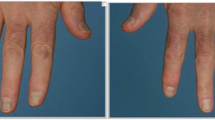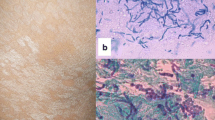Abstract
The side-effects of many drugs manifest in the oral mucosa. The anti-malarial agent chloroquine diphosphate, which is also used to treat immunological, dermatological, and rheumatological disorders, usually causes pigmentary changes in the oral mucosa. This report presents a case of palate pigmentation related to the prolonged use of chloroquine diphosphate caused by the deposition of drug metabolites in the mucosa. Healthcare professionals must be aware of these drugs and their adverse effects in order to make the correct diagnosis, decide on the optimal treatment for the condition, or refer the patient to an appropriate specialist.



Similar content being viewed by others
References
Porter SR, Scully C. Adverse drug reactions in the mouth. Clin Dermatol. 2000;18:525–32.
Arana LA, Arana J, Hasimoto AR, et al. Tomografia de coerência óptica na avaliação da camada de fibras nervosas peripapilar nos usuários de cloroquina. Arq Bras Oftalmol. 2010;73:28–32.
Kleinegger CL, Hammond HL, Finkelstein MW. Oral mucosal hyperpigmentation secondary to antimalarial drug therapy. Oral Surg Oral Med Oral Pathol Oral Radiol Endod. 2000;90:189–94.
Martin TJM, Sharp I. Oral mucosal pigmentation secondary to treatment with mepacrine, with sparing of the denture bearing área. Br J Oral Maxillofac Surg. 2004;42:351–3.
Gouveia EB, Morales MAS, Gouveia GB, et al. Toxicidade ocular por derivados da 4-aminoquinolona. Arq Bras Oftalmol. 2007;70:1046–51. [online].
Seymour RA, Rudralingham M. Oral and dental adverse drug reactions. Periodontology. 2000;2008(46):9–26.
Lacava AC. Complicações oculares da terapêutica com a cloroquina e derivados. Arq Bras Oftalmol. 2010;73:384–9.
Rodrigues LD, Shinjo SK, Oyamada MK, et al. Métodos diagnósticos para retinopatia induzida pelo difosfato de cloroquina nos portadores de lúpus eritematoso sistêmico. Arq Bras Oftalmol. 2009;72:313–20. (online).
Lerman MA, Karimbux N, Guze KA, et al. Pigmentation of the hard palate. Oral Surg Oral Med Oral Pathol Oral Radiol Endod. 2009;107:8–12.
Author information
Authors and Affiliations
Corresponding author
Rights and permissions
About this article
Cite this article
de Melo Filho, M.R., da Silva, C.A.D., da Rocha Dourado, M. et al. Palate Hyperpigmentation Caused by Prolonged Use of the Anti-Malarial Chloroquine. Head and Neck Pathol 6, 48–50 (2012). https://doi.org/10.1007/s12105-011-0288-5
Received:
Accepted:
Published:
Issue Date:
DOI: https://doi.org/10.1007/s12105-011-0288-5




